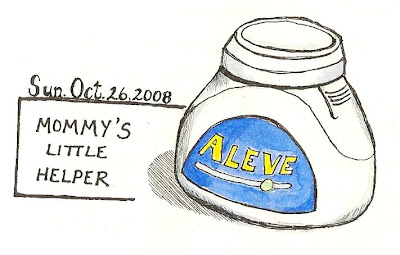The following instructions are how to make the yellow sketchbook cover on the left.
The instructions for making the paint blob cover on the right are
here, and instructions for folding the paper for the pages are
here.

MATERIALS NEEDED

Scissors, glue, pencil, paper scoring tool, cardstock and a ruler. I used a ZIG glue pen because that's what I had on hand. The bright green thing is a paper scoring tool, but a dull letter opener (shown), or a dull butter knife will work fine. Just don't use anything sharp that might cut into the fiber of the cardstock.
I used 9x12" watercolor paper for the pages (90 lb Canson cold press) so the folded paper block ended up being 2.25x3". An 8x8" piece of cardstock was the perfect size for the cover. If you use a larger sheet of WC paper for the pages you will need larger cardstock. The cover cardstock should be almost three times the height and width of the folded paper block.
THE CONCEPT
Each side of the cover is basically an envelope. The first and last page of the paper block slides into each side.

Cut and fold this shape, then glue together the flaps on each side.

DETAILED INSTRUCTIONS
Measure and mark a 1.25" strip across the bottom for the strap.
Hold the paper block on its spine in the approximate middle of the remaining space. Exact measurements aren't critical here. I just eyeballed it. Draw a loose pencil line all the way around. Again, precision isn't critical here. I've done it with a black marker so it would show in the photo. This will be the spine area of the sketchbook.

Cut the strap portion off and set aside for later.
Just a smidge outside the drawn spine block, score a line all the way across the cardstock. Do this on all four sides. How big the "smidge" is depends on how much larger you want the cover relative to the pages. Err on the side of larger rather than smaller. If the cover is too close to the measurement of the paper block pages, the pages will be difficult to slide in.
CRITICAL: ALL SCORED LINES MUST BE ABSOLUTELY PARALLEL TO EACH OTHER AND THE EDGES OF THE CARDSTOCK.
That's the only critical part of the whole project. If the lines are not parallel, the cover will be a whomperjawed mess. Measure and score carefully.
The scoring lines are shown below in red (and black).

Lay the paper block down against the spine line and mark just beyond the edge of the pages. This will mark the width of the cover. Do this on both sides.

Score a line through that mark all the way across the cardstock. The project should now look like this:

Cut the corners off and cut down to the spine block on the top and bottom. There needs to be a little "ease" in the cuts because of the thickness of the cardstock. The eased cutting lines are shown below as dashed green lines. Click to embiggen:

After cutting it should look like this:

You might notice the bottom flaps are a little larger than the top flaps, and one side flap is larger than the other. Not a problem; don't worry about it.
Fold along all the scored lines and crease them sharply. I used the handle of the letter opener for this.

Determine which set of upper or lower flaps are larger and re-orient the project so they are at the top. The closer the edge of the top flap is to the bottom of the cover, the neater it will look.

All the flaps numbered for reference:

Fold up all the flaps in order. Then fold each side of the cover over onto the other to make sure it folds over flat. The inside edge of the flaps next to the spine may need to be trimmed to prevent bunching. Check the outside edges of the flaps to see if they need any trimming.

Glue the spine flaps to the spine - Bottom one (1) up first, then top one (2) down:

Fold in side flap (3) and fold bottom flap (4) over it. Make a mark where the two meet on the side flap.

Put glue on the side flap only in the area below the mark and glue the bottom flap to it. Let dry. Be sure not to get glue anywhere in Area B or the "envelope" will be glued shut!

Fold the top flap down and mark the edges. Open and apply glue on side and bottom flaps within the marks. Oops! I didn't do this step before I markered the glue lines.

I would have had a mess with a bunch of gummy glue hanging out.

Repeat the gluing process for the other side. The cover is complete.
Slide the paper block into the cover.


The sketchbook is complete!
THE STRAP CLOSURE (optional)
This is just a simple glued band of cardstock.
Wrap the strap around the book as tightly or loosely as you prefer. Allow about one and a half inches overlap for gluing. Mark the end for cutting.

Add decoration and glue together.

Slip the strap around the sketchbook and you're done!




















































